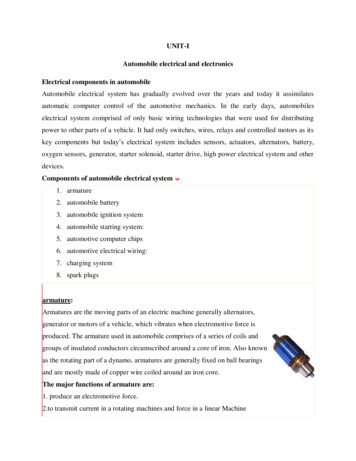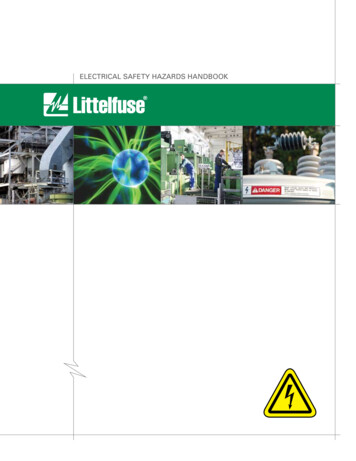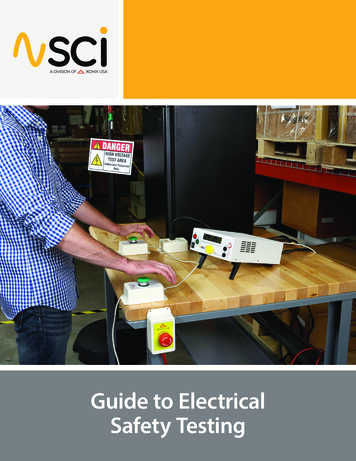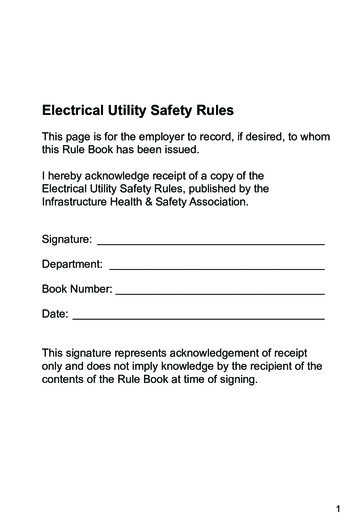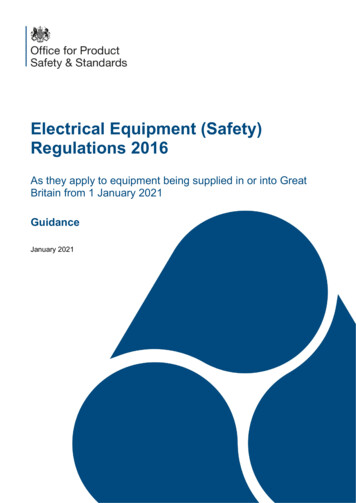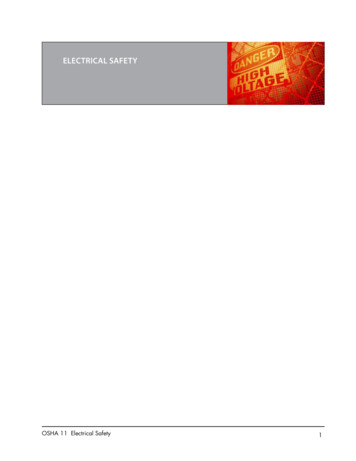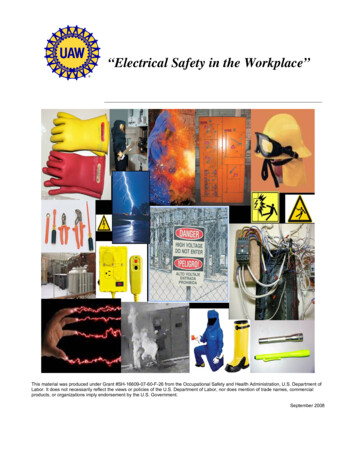
Transcription
“Electrical Safety in the Workplace”This material was produced under Grant #SH-16609-07-60-F-26 from the Occupational Safety and Health Administration, U.S. Department ofLabor. It does not necessarily reflect the views or policies of the U.S. Department of Labor, nor does mention of trade names, commercialproducts, or organizations imply endorsement by the U.S. Government.September 2008
“Electrical Safety in the Workplace”Course Goal – The aim of this program is to provide comprehensive on-site training to high-risk workers (i.e.skilled trades and maintenance workers) and management on the requirements of Sub Part S, and the preventionof serious injuries from electrical hazards at their worksites. Participants will develop understanding of therequirements of OSHA Sub Part “S” and NFPA, 70E and will be able to identify and reduce or eliminateelectrical safety hazards in their workplace. Electrical Safe Work Practices including electrical safety principles,guidelines for qualification of personnel, job planning requirements and Management and PersonalResponsibility will be covered.Section1234ContentIntroduction toElectrical SafetyIdentifying theHazardsOSHARequirementsSafety Related WorkPracticesObjectiveParticipants will be able to: Explain the issues (statistics) associated with poor electrical safety in the workplace. Recall key electrical terms which are essential to understanding and meeting therequirements of key electrical safety standards; i.e. OSHA 29 CFR 1910.331-.335,NFPA 70E, NEC (NFPA 70) Define and differentiate between qualified and unqualified persons under OSHASub Part S. and the training requirements for each. Describe the intent of an Electrical Safety Program and list the essential elements ofan effective program. Use a “Status Check” survey to assess the facility’s electrical safety program andwhere necessary develop strategies for improvement.Participants will be able to: List types of electrical hazards to personnel and describe the nature of the hazardsrelated to:o Electric shocks, arcs and blastso Fault current and potential differenceo Electrical safety in industrial plants List the characteristics of an arc flash hazard List the characteristics of an arc blast hazard Explain how other injury hazards are related to shock, flash, and blastParticipants will be able to: Identify requirements specified in OSHA 29 CFR 1910.301-.308 and NFPA 70E2004 Chapter 4 and describe similarities and differences in OSHA and 70E. Explain how NFPA 70E is used in OSHA compliance and enforcement. Determine training for workers in accordance with OSHA Sub Part S requirements. Recall Safe Installation Practices including:o Guardingo Identificationo Flexible cords and cableso System groundingo Location of overcurrent protection deviceso Workspace clearance requirements Assess an electrical installation for compliance with OSHA regulations. Explain the reasons for doing a site assessment to determine arc flash hazardpotential for equipment and electrical enclosure.Participants will be able to: Identify requirements for electrical safe work practices specified in OSHA 29 CFR1910.331-.335 and NFPA 70E Chapter 1 Define an “Electrically Safe Work Condition” and list specific steps to be taken toensure an electrically safe work condition. Explain how the creation of an electrically safe work condition can involve hazards2
“Electrical Safety in the Workplace”and the methods to protect against them. Describe the facility’s lockout/tagout (LO/TO) procedure including requirementsand activities in the procedure and identify the persons responsible for each activity. Determine the LO/TO procedure applicable to a given facility, operation, equipmentor activity. Describe other safety related work practices to protect from electrical hazardsincluding:o Selection and use of work practiceso De-energized work practiceso Energized work practiceso Approach boundaries and approach distanceso Requirements for use of test instruments and equipmento Requirements for insulated toolso Other equipment such as ladders, barricades, signs5Working On or NearLive PartsParticipants will be able to: Identify persons who may be exposed to a source of electrical energy directly orindirectly. List the conditions under which “hot work” is allowed. Describe the purposes of an energized electrical work permit. Recall three types of approach boundaries and define the dimensions of eachapproach boundary, given all necessary information. Describe the essential parts of a Flash Hazard Analysis and list the data requiredanalysis. List the information, including Hazard Risk Category, provided to a worker by aFlash Hazard Analysis and describe its use.6Personal ProtectiveEquipment (PPE)Participants will be able to: List the basic types of personal protective equipment (PPE) for tasks involvingelectrical hazards. Describe how each type protects against hazards and identify the limitations of PPE. Explain the need for flame resistant (FR) clothing and layering of clothing forprotection and list clothing prohibited where electrical hazards are present. Select PPE for a given Hazard Risk Category including gloves, eye, head, faceprotection and (FR) clothing. Describe the requirements for use, care, maintenance and storage of PPE.7Action Planning andCourse Wrap-upParticipants will be able to: Outline an Action Plan to achieve compliance with OSHA Subpart S and NFPA70E. Provide assistance to help achieve workplace goals of OSHA Subpart S and NFPA70E compliance.3
“Electrical Safety in the Workplace”AGENDASectionContentPage #1*Introduction to Electrical Safety6.2*Identifying the Hazards13.3*OSHA Requirements28.4Safety Related Work Practices33.5Working On or Near Live Parts35.6Personal Protective Equipment40.7Action Planning and Course Wrap-up62.* Denotes Electrical Hazard Awareness training sections.4
“Electrical Safety in the Workplace”IntroductionsIndividual Introductions: Your name, worksite, local union, job title and/or Union titleIntroductions:1. How long have you been doing electrical repairs or troubleshooting?2. What electrical responsibilities do you know are within your training?1)2)3. What electrical responsibilities do you know are outside your training?1)2)4. What type of Personal Protective Equipment (PPE) is available to you when workingon or near live electrical equipment?Answer the following throughout the session -5. What action does your facility need to take to comply with the revised ElectricalStandards?Sticky notes are at the tables. As we cover ideas, you’ll think, “Our facility needs to do(fill in the blank) to take care of this!” When you do, write that action on a post-it note,along with the page number that sparked it. Pile the notes in front you. They will be usedin the wrap-up planning exercise.5
“Electrical Safety in the Workplace”A Checklist to Clarify StatusColumn 1 -- Do these items describe your facility? Answer YES, NO, or SOMEWHATITEM -- Each sentence starts with “Does Your Facility .”1. work on 50V or more?2. have all breakers and switches marked for what it goes to?3. provide Lockout/Tagout (LOTO) training for everyone?4. .provide GFI protection for extension cords and electric portable tools?5. provide Flame Retardant (FR) clothing to “qualified” personnel?6. .stress LOTO before doing any service or maintenance on electrical components?7. inspect electrical cords on portable tools and extension cords prior to each use?8. have a procedure for taking damaged cords out of service for repairs prior to use?9. have all panels / Electrical Cabinets marked for voltage?10. .provide “Electrical Hazard Awareness Training” for everyone?11. .reset breakers with “qualified” personnel?12. .have an electrical room or vault?13. .is the room secured to prevent “unqualified” personnel from entering?14. .use dielectric tested gloves when working on/near live electrical parts?15. use insulated tools when working on/near live electrical parts?16. .do Preventitive Maintenance on circuit breakers and switches at least annually?17. .have 40 cal/cm2 suits available?18. .have buss plugs that are changed by personnel?19. .work on live electrical equipment to trouble shoot or because it can’t be shut down?20. .have all the incident energy calculated and Arc Flash Boundaries set for all serviceconnections of 50V or more?21. are the boundaries posted on panels/disconnects?22. .use a “Hot Electrical Work Permit” system?23. install new equipment or rebuild older equipment?24. .keep all electrical cabinets and electrical disconnects clear (36”)?25. use approved electrical test devices?26. .have someone trained in CPR-1st Aid and AED?27. inspect PPE prior to each use?3. Circle the top 5 items that your facility most needs to improve.4. Next, compare your responses to those of others in your group:What are the common concerns? Where are the differences? What work has to be done?61
“Electrical Safety in the Workplace”What’s wrong here?What’s the problem?Can this cabinet be turned back on and create a hazard?How many hazards/violations are there in this picture? .7
“Electrical Safety in the Workplace”A Little History of Electricity600BC: Static electricityThales, a Greek, found that when amber was rubbed with silk it attracted feathers and otherlight objects. He had discovered static electricity. The Greek word for amber is elektron', fromwhich we get electricity' and electronics'.1600: William Gilbert invented the term electricityWilliam Gilbert, scientist and physician to Queen Elizabeth I, coined the term electricity. Hewas the first person to describe the earth's magnetic field and to realize that there is arelationship between magnetism and electricity.1752: Franklin proved that lightning is a form of electricityBenjamin Franklin, famous U.S. politician, flew a kite with a metal tip into a thunderstorm toprove that lightning is a form of electricity.1820: Hans Christian Oersted discovered magnetic fields caused by electricityHans Christian Oersted of Denmark found that when electricity flows through a wire, itproduces a magnetic field that affects the needle of a nearby compass.1821: Michael Faraday's discovery that led to the invention of electric motorsMichael Faraday discovered that when a magnet is moved inside a coil of copper wire, a tinyelectric current flows through the wire. This discovery later led to the invention of electricmotors.1826: André Ampère explained the electro-dynamic theoryAndré Ampère published his theories about electricity and magnetism. He was the first personto explain the electro-dynamic theory. The unit of electric current was named after Ampère.1827: Georg Ohm published his complete mathematical theory of electricityGerman college teacher Georg Ohm published his complete mathematical theory of electricity.The unit of electrical resistance was later named after him.1831: The First Telegraph MachineCharles Wheatstone and William Fothergill Cooke created the first telegraph machine.1838: Samuel Morse invented Morse CodeAt an exhibition in NewYork, Samuel Morse demonstrated sending 10 words a minute by hisnew telegraph machine. He used a system of dots and dashes, which later became standardthroughout the world, known as Morse code.1870s: Thomas Edison built a DC electric generatorThomas Edison built a DC (direct current) electric generator in America. He later provided all ofNew York's electricity.1876: Alexander Graham Bell invented the telephoneAlexander Graham Bell, inventor of the telephone, used electricity to transmit speech for the first time.8
“Electrical Safety in the Workplace”1878: Joseph Swan demonstrated the first Electric LightThomas Edison demonstrated the first electric light with a carbon filament lamp.1879:First fatal accident due to electric shock.1800’s: Nicola Tesla devised the AC (Alternating Current) system for electrical transmissionthat is used in homes, businesses and industry today. He also invented the motors that run onAC and designed the world’s first Hydroelectric Plant (in Niagara Falls, NY).1895: The first electric hand drillThe first electric hand drill became available, invented by Wilhelm Fein.1918-19: Washing machines and refrigeratorsElectric washing machines and refrigerators first became available.1926: First National Grid was introducedElectricity Supply Act - the first National Grid was introduced.1930-40s: Electrical household appliances introducedMains powered radios, vacuum cleaners, irons and refrigerators were becoming part of everyhousehold.1936: John Logie Baird pioneered the television.17529
“Electrical Safety in the Workplace”What Is Electricity?Electricity is everywhere in our lives. Electricity lights up our homes, cooks our food, powersour computers, television sets, and other electronic devices. Electricity (DC Current) frombatteries starts our cars and makes our flashlights shine in the dark.But what is electricity? Where does it come from? How does it work? What are the hazards?Before we understand all that, we need to know a little bit about atoms and their structure.All matter is made up of atoms, and atoms are made up of smaller particles. The three mainparticles making up an atom are the proton, the neutron and the electron.Electrons spin around the center, or nucleus. The nucleus is made up of neutrons and protons.Electrons contain a negative charge, protons a positive charge. Neutrons are neutral -- theyhave neither a positive nor a negative charge.Each atom has a specific number of electrons, protons and neutrons. But no matter how manyparticles an atom has, the number of electrons usually needs to be the same as the number ofprotons. If the numbers are the same, the atom is called balanced, and it is very stable.So, if an atom had six protons, it should also have six electrons. The element with six protonsand six electrons is called carbon. Carbon is found in abundance in the sun, stars, comets,atmospheres of most planets, and the food we eat. Coal is made of carbon; so are diamonds.Some kinds of atoms have loosely attached electrons. An atom that loses electrons has moreprotons than electrons and is positively charged. An atom that gains electrons has morenegative particles and is negatively charged. A "charged" atom is called an "ion."Electrons can be made to move from one atom to another. When those electrons movebetween the atoms, a current of electricity is created. The electrons move from one atom toanother in a "flow." One electron is attached and another electron is lost.Since all atoms want to be balanced, the atom that has been "unbalanced" will look for a freeelectron to fill the place of the missing one. We say that this unbalanced atom has a "positivecharge" ( ) because it has too many protons.Since it got kicked off, the free electron moves around waiting for an unbalanced atom to giveit a home. The free electron charge is negative, and has no proton to balance it out, so we saythat it has a "negative charge" (-).10
“Electrical Safety in the Workplace”So what do positive and negative charges have to do with electricity?The more positive atoms or negative electrons you have, the stronger the attraction for theother. Since we have both positive and negative charged groups attracted to each other, wecall the total attraction "charge."When electrons move among the atoms of matter, a current of electricity is created. This iswhat happens in a piece of wire. The electrons are passed from atom to atom, creating anelectrical current from one end to other.Short definition of “ELECTRICITY”: is the flow of electrons through a conductor.Electricity is conducted through some materials better than others. Its resistance measureshow well something conducts electricity. Some things hold their electrons very tightly.Electrons do not move through them very well. These things are called insulators. Rubber,plastic, cloth, glass and dry air are good insulators and have very high resistance.Other materials have some loosely held electrons, which move through them very easily.These are called conductors. Most metals -- like copper, aluminum or steel -- are goodconductors.Electrical (S) Properties of electricity: Must complete a circuitÆ Seeks easiest and “all’ pathsto ground11
“Electrical Safety in the Workplace”Where Does the Word 'Electricity' Come From?Electrons, electricity, electronic and other words that begin with "electr." all originate from the Greek word"elektor," meaning "beaming sun." In Greek, "elektron" is the word for amber.Amber is a very pretty goldish brown "stone" that sparkles orange and yellow in sunlight. Amber is actuallyfossilized tree sap!Ancient Greeks discovered that amber behaved oddly - like attracting feathers - when rubbed by fur or otherobjects. They didn't know what it was that caused this phenomenon. But the Greeks had discovered one of thefirst examples of static electricityThe Latin word, electricus, means to "produce from amber by friction."The English word electricity is from Greek and Latin words that were about amber.OSHA Trade News ReleaseFeb. 13, 2007Contact: Elaine FraserPhone: (202) 693-1999OSHA Issues Final Rule on Electrical Installation StandardWASHINGTON -- The Occupational Safety and Health Administration will publish a final rule in tomorrow's FederalRegister for an updated electrical installation standard."These are the first changes to the electrical installation requirements in 25 years, so it is important the standardreflects the most current practices and technologies in the industry," said Assistant Secretary for Occupational Safetyand Health Edwin G. Foulke Jr. "The revised standard strengthens employee protections and adds consistencybetween OSHA's requirements and many state and local building codes which have adopted updated NationalFire Protection Association (NFPA) and National Electrical Code provisions."Changes to OSHA's general industry electrical installation standard focus on safety in the design and installation ofelectric equipment in the workplace. The updated standard includes a new alternative method for classifying andinstalling equipment in Class I hazardous locations; new requirements for ground-fault circuit interrupters (GFCIs)and new provisions on wiring for carnivals and similar installations.The final rule updates the general industry electrical installation requirements to the 2000 edition of the NFPA70E, which was used as the foundation of the revised standard. The final rule also replaces the reference to the1971 National Electrical Code in the mandatory appendix to the powered platform standard with a reference to OSHA'selectrical installation standard.Under the Occupational Safety and Health Act of 1970, employers are responsible for providing a safe and healthfulworkplace for their employees. OSHA's role is to assure the safety and health of America's working men and women bysetting and enforcing standards; providing training, outreach, and education; establishing partnerships; and encouragingcontinual process improvement in workplace safety and health. For more information, visit www.osha.gov.12
“Electrical Safety in the Workplace”Federal Register February 14, 2007 (Action, Summary and Effective Date):Department of LaborOccupational Safety and Health Administration29 CFR Part 1910; Electrical Standard; Final RuleACTION: Final rule.SUMMARY:The Occupational Safety and Health Administration (OSHA) is revising the general industryelectrical installation standard found in Subpart S of 29 CFR Part 1910. The Agency hasdetermined that electrical hazards in the workplace pose a significant risk of injury or death toemployees, and that the requirements in the revised standard, which draw heavily from the2000 edition of the National Fire Protection Association's (NFPA) Electrical SafetyRequirements for Employee Workplaces (NFPA 70E), and the 2002 edition of theNational Electrical Code (NEC), are reasonably necessary to provide protection from thesehazards. This final rule focuses on safety in the design and installation of electric equipment inthe workplace. This revision will provide the first update of the installation requirements in thegeneral industry electrical installation standard since 1981.DATES: This final rule becomes effective on August 13, 2007.Hazards Associated With ElectricityElectricity is widely recognized as a serious workplace hazard, exposing employees toelectric shock, burns, fires, and explosions. According to the Bureau of Labor Statistics, 250employees were killed by contact with electric current in 2006. Other employees have beenkilled or injured in fires and explosions caused by electricity.It is well known that the human body will conduct electricity. If direct body contact is madewith an electrically energized part while a similar contact is made simultaneously with anotherconductive surface that is maintained at a different electrical potential, a current will flow,entering the body at one contact point, traversing the body, and then exiting at the othercontact point, usually the ground. Each year many employees suffer pain, injuries, and deathfrom such electric shocks.Current through the body, even at levels as low as 3 milliamperes, can also cause injuries ofan indirect or secondary injuries in which involuntary muscular reaction from the electricshock can cause bruises, bone fractures and even death resulting from collisions or falls.13
“Electrical Safety in the Workplace”ShockCurrent, Not Voltage causes Electric ShockmA0.5 - 33 - 10Affect on Person- Tingling sensations- Muscle contractions and pain10 - 40- “Let-go” threshold30 - 75- Respiratory paralysis100 - 200- Ventricular fibrillation200 - 500- Heart clamps tight1500 - Tissue and Organs start to burnBurns suffered in electrical accidents can be very serious. These burns may be of threebasic types: electrical burns, arc burns, and thermal contact burns. Electrical burns arethe result of the electric current flowing in the tissues, and may be either skin deep or mayaffect deeper layers (such as muscles and bones) or both. Tissue damage is caused by theheat generated from the current flow; if the energy delivered by the electric shock is high, thebody cannot dissipate the heat, and the tissue is burned. Typically, such electrical burns areslow to heal. Arc burns are the result of high temperatures produced by electric arcs or byexplosions close to the body. Finally, thermal contact burns are those normally experiencedfrom the skin contacting hot surfaces of overheated electric conductors, conduits, or otherenergized equipment. In some circumstances, all three types of burns may be producedsimultaneously.If the current involved is great enough, electric arcs can start a fire. Fires can also becreated by overheating equipment or by conductors carrying too much current. Extremely highenergy arcs can damage equipment, causing fragmented metal to fly in all directions. Inatmospheres that contain explosive gases or vapors or combustible dusts, even low-energyarcs can cause violent explosions.14
“Electrical Safety in the Workplace”Electrical ArcMolten Metal35,000 FPressure WavesSound WavesCopper Vapor:ShrapnelSolid to VaporExpands by67,000 timesHot Air-Rapid ExpansionIntense LightNature of Electrical AccidentsElectrical accidents, when initially studied, often appear to be caused by circumstances thatare varied and peculiar to the particular incidents involved. However, further considerationusually reveals the underlying cause to be a combination of three possible factors: workinvolving unsafe equipment and installations; workplaces made unsafe by theenvironment; and unsafe work practice. The first two factors are sometimes consideredtogether and simply referred to as unsafe conditions. Thus, electrical accidents can begenerally considered as being caused by unsafe conditions, unsafe work performance or, inwhat is usually the case, combinations of the two. It should also benoted that inadequate maintenance can cause equipment or installationsthat were originally considered safe to deteriorate, resulting in an unsafe condition.Some unsafe electric equipment and installations can be identified, for example, by thepresence of faulty insulation, improper grounding, loose connections, defective parts, groundfaults in equipment, unguarded live parts, and underrated equipment. The environment canalso be a contributory factor to electrical accidents in a number of ways. Environmentscontaining flammable vapors, liquids, or gases; areas containing corrosive atmospheres; andwet and damp locations are some unsafe environments affecting electrical safety. Finally,unsafe acts include the failure to de-energize electric equipment when it is beingrepaired or inspected or the use of tools or equipment too close to energized parts.(Control of Hazardous Energy – Lockout/Tagout)As stated earlier, electricity has long been recognized as a serious workplace hazardexposing employees to dangers such as electric shock, electrocution, fires, and explosions.The 100-year-long history of the National Electrical Code, originally formulated and periodicallyupdated by industry consensus, attests to this fact. The NEC has represented the continuingefforts of experts in electrical safety to address these hazards and provide standards for15
“Electrical Safety in the Workplace”limiting exposure in all electrical installations, including workplaces. OSHA has determined thatelectrical hazards in the workplace pose a significant risk of injury or death to employees andthat the final rule, which draws heavily on the experience of the NEC, will substantially reducethis risk.According to the U.S. Bureau of Labor Statistics, between 1992 and 2006, an average of283 employees died per year from contact with electric current. This downward trend (Seepage 18) is due, in major part, to 30 years of highly protective OSHA regulation in the area ofelectrical installation, based on the NEC and NFPA 70E standards. The final standard carriesforward most of the existing requirements for electrical installations, with the new and revisedrequirements intended as fine tuning, introducing new technology along with otherimprovements in safety. By complying with the final standard, employers will prevent unsafeelectrical conditions from occurring.While the number of deaths and injuries associated with electrical hazards has declined,contact with electric current still poses a significant risk to employees in the workplace,as evidenced by the numbers of deaths and serious injuries still occurring due to contact withelectric current. This final rule will help further reduce the number of deaths and injuriesassociated with electrical hazards by providing additional requirements for installation safetyand by recognizing alternative means of compliance.On February 16, 1972, OSHA incorporated the 1971 edition of the National Fire ProtectionAssociation's (NFPA) National Electrical Code (NEC), NFPA 70-1971, by reference as itselectrical standard for general industry. The Agency followed the procedures outlined inSection 6(a) of the Occupational Safety and Health Act of 1970, which directed the Secretaryto adopt existing national consensus standards as OSHA standards within 2 years of theeffective date of the OSH Act. In incorporating the 1971 NEC by reference, OSHA made theentire 1971 NEC applicable to all covered electrical installations made after March 15, 1972.For covered installations made before that date, OSHA listed about 16 provisions from the1971 NEC that applied.On January 16, 1981, OSHA revised its electrical installation standard for general industry.This revision replaced the incorporation by reference of the 1971 NEC with relevantrequirements from Part I of the 1979 edition of NFPA 70E. The revision simplified and clarifiedthe electrical standard and updated its provisions to match the 1978 NEC (the latest editionavailable at the time). The standard was written to reduce the need for frequent revision and toavoid technological obsolescence. These goals were achieved--NFPA 70E had only minorchanges over its initial 15 years of existence. The first substantial changes were introduced inthe 1995 edition of NFPA 70E.The 2000 edition of NFPA 70E contains a number of significant revisions, including a new,alternative method for classifying and installing equipment in Class I hazardous locations.NFPA has recommended that OSHA revise its general industry electrical standards to reflectthe latest edition of NFPA 70E, arguing that such a revision would provide a needed update tothe OSHA standards and would better protect employees. This final rule responds to NFPA'srecommendations with regard to installation safety. It also reflects the Agency's commitment toupdate its electrical standards, keep them consistent with NFPA standards, and ensure thatthey appropriately protect employees. OSHA intends to extend this commitment by using16
“Electrical Safety in the Workplace”NFPA 70E as a basis for future revisions to its electrical safety-related work practicerequirements and new requirements for electrical maintenance and special equipment.Branch Circuits--Ground-Fault Circuit-Interrupters for EmployeesEach year many employees suffer electric shocks while using portable electric tools andequipment. The nature of the injuries ranges from minor burns to electrocution. Electric shocksproduced by alternating currents (ac) at power line frequency passing through the body of anaverage adult from hand to foot for 1 second can cause various effects, starting from acondition of being barely perceptible at 1 milliampere to loss of voluntary muscular control forcurrents from 9 to 25 milliamperes. The passage of still higher currents, from 75 milliamperesto 4 amperes, can produce ventricular fibrillation of the heart; and, finall
“Electrical Safety in the Workplace” 2 Course Goal – The aim of this program is to provide comprehensive on-site training to high-risk workers (i.e. skilled trades and maintenance workers) and managem



